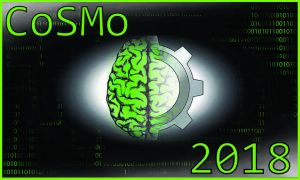CoSMo 2018: Difference between revisions
| Line 171: | Line 171: | ||
'''Abstract''': At a glance, we perceive whether the ground is icy or safe to walk on with an intuitive understanding about the physical properties of objects. Here, we investigate how people weight object size and friction in their interpretations. Participants passively view a video of a cube on a rotating plane. They are then asked to tilt the plane to the maximum estimated angle at which they expect the object to start sliding. Our results highlight a common misconception of intuitive physics demonstrating a deviance from an ideal observer model which predicts that size does not play a role for friction estimation. | '''Abstract''': At a glance, we perceive whether the ground is icy or safe to walk on with an intuitive understanding about the physical properties of objects. Here, we investigate how people weight object size and friction in their interpretations. Participants passively view a video of a cube on a rotating plane. They are then asked to tilt the plane to the maximum estimated angle at which they expect the object to start sliding. Our results highlight a common misconception of intuitive physics demonstrating a deviance from an ideal observer model which predicts that size does not play a role for friction estimation. | ||
''3 - 3:30pm'' | | ''3 - 3:30pm'' | | ||
'''Better Call Paul (B.C.P.)''': Jana Masselink | Serena Ricci | Judith Rudolph | Marion Forano <br> | |||
'''Project title''': Does motor variability influence learning in uncertain situations? <br> | |||
'''Abstract''': We seem to benefit from variability introduced by our own motor system, but experiencing environmental uncertainty reduces our ability to learn. However, it has not yet been investigated how motor variability modulates the effect of environmental uncertainty on visuomotor adaptation. Here we use an adaptive Kalman filter to predict adaptation behavior under different perturbation uncertainties. We show that for higher motor noise and perturbation uncertainty, adaptation rate and final compensation increase, and difference in motor variance decreases. Therefore, this study shows that larger variabilities in movements aid learning under greater uncertainty. <br> | |||
''3:30 - 4pm'' | | |||
'''Face Adaptation Networks (FANs)''': Sunwoo Kwon | Tina Liu | Cindy Tu | Nils Yang <br> | |||
'''Project title''': Perception of face gender under ambiguity: neural network of face adaptation <br> | |||
'''Abstract''': Our perception of the gender of a face is dependent on the recent gender history. Face adaptation studies suggest that constant exposure to one gender shifts the perception to the opposite gender. However, we are currently lacking models that can successfully describe this behavioral phenomenon. We thus implement a neural network model of face gender perception. We find that this model faithfully captures the dependency of face perception on gender history. This demonstrates that perception of gender is influenced by the frequency of exposure to gender faces. <br> | |||
Revision as of 19:59, 10 August 2018

This page contains course materials for the CoSMo 2018 summer school.
Introduction
Jul 30 - Aug 4
Lecturers: Gunnar Blohm, Paul Schrater, Konrad Kording
Day 1 - Overview of modeling in neuroscience
CoSMo 2018 organizational slides
Konrad's and Gunnar's model pitches
Paul's multiple learning pitch
Paul's optimal forgetting pitch
Paul's deep learning bottleneck pitch
Paul's minimum intervention principle pitch
Afternoon tutorial 1: plotting neural data
Here is the file [Stevenson Data Set]
As part of the tuning curve exercise we will understand it.
Tutorial is available here
Afternoon tutorial 2: gain modulation for reference frame transformations
The goal of this tutorial is to understand how gain modulation can be used for reference frame transformations and how gain modulation can emerge from training a simple artificial neural network carrying out reference frame transformations.
There are 2 different approaches to solving this:
- exact determination of read-out weights from eye-position gain-modulated neurons as in this seminal paper. Here the solution can be found by computing the least-square optimal set of weights mapping the gain-modulated neurons (population code) to head-centered output neuron(s). For this to work, population code neurons need to be of the exponential function family.
- training a neural network to perform reference frame transformations using this code. For this you can plot each individual neuron's receptive field for different eye positions and analyze how the receptive field changes with eye position in each network layer.
Day 2 - Bayesian approaches
Bayesian perception - an introduction: a tremendous book written by Wei Ji Ma, Konrad Kording, Daniel Goldreich
Morning lectures & tutorial
Konrad's Bayesian decoding and multi-sensory integration tutorials are available
here (in folder day 2)
Afternoon lectures & tutorials
Dropbox link to Paul's slides and tutorial (in sub-folder decision_tutorial)
How to model tutorial
Modeling 101 slides
Day 3 - Linear systems and Kalman filtering
Morning: Linear systems (saccades)
Linear systems theory lecture
Eye movement tutorial and a possible solution for both time and frequency domain modelling
van Opstal syllabus - linear systems theory: a great syllabus developed by John van Opstal for CoSMo on using linear systems to model gaze control with theory, exercises and answers to exercises
Afternoon: Kalman filtering
Dropbox link to Paul's slides and tutorial (in sub-folder Kalman_lecture_tutorial)
Day 4 - Motor control
Morning: optimal control
Control slides
Matlab control tutorial files
Afternoon: Paper writing 101
Individual abstract writing document
Konrad's PLoS CB 10 simple rules paper on how to structure papers
Evening: causality in neuroscience
Konrad's discussion slides and tutorials on causality in neuroscience can be found here (in sub-folder causality)
Day 5 - Optimality
Can a neuroscientist understand a mirco-chip?
Konrad's article discussing this is published here
BADS model fitting
Lecturer: Luigi Acerbi
Luigi's slides
Here is the link to Luigi's tutorial files on Github.
Day 6 - machine learning
Konrad's tutorial on machine learning for neuroscience can be found here (in sub-folder ML)
Motor control
Aug 6 - 7
Lecturers: Alaa Ahmed, Frederic Crevecoeur, Reza Shadmehr
Alaa's and Reza's first day materials
Reza's neural prelude to movement slides
Alaa's PM tutorial
Reza's neural coding in the cerebellum slides
Reza's reaction time slides
Alaa's slides (all in one deck)
Fred's control tutorial
Lecture slides and further readings
Tutorial instructions and associated Matlab script
The Bayesian Brain
Aug 8 - 9
Lecturers: Megan Peters & Larry Maloney
Day 1
Larry's introductory lecture
Larry's first tutorial
Second lecture from Larry
Second set of exercises from Larry
Day 2
Larry's third lecture slides
Larry's 4th slide deck
Larry's last set of slides
Open Science & other discussions
Aug 9
Open science and strategies to become a modeller slides. YOU CAN DO IT!!!
Group Projects
Jul 30 - Aug 11
Instructions: Every group will have a 30min slot (20min presentation, 10min questions). The research question, hypotheses and rationale for the choice of the approach should be clearly presented. Models, simulations, results, discussion etc should be detailed enough for everyone to follow.
Best group gets a free 10min talk at Advances in Motor Control and Motor Learning 2018 (SfN satellite workshop)!!! (confirmed by John Krakauer & Maurice Smith)
The winner has to apply too and specify you are CoSMo 2018 project winner...
PROJECT PRESENTATIONS (Sat, Aug 11)
Presentations will take place 1-6pm in Bruininks Hall Room 512B
Presentation template PowerPoint file
1 - 1:30pm |
Smooth Optimator5 (S.O.5): Clara Cámara | Benjamin Cuthbert | Stephan Dobri | Tom Nissens | Marta Russo
Project title: "Not So Smooth: Modelling Reaching Behaviour of Children with Developmental Coordination Disorder"
Abstract: Reaching movements in healthy subjects usually display one-peak speed profiles. Children with Developmental Coordination Disorder (DCD) instead exhibit intermittent trajectories with multiple peaks in the speed profile. The underlying mechanism is still debated. Here we investigated whether a violation in the internal model of the arm dynamics can cause the observed characteristics of DCD, by means of Optimal Feedback Control (OFC). We found that small changes in the internal model resulted in curved paths and rough speed profiles. We suggest a new hypothesis for DCD deficits: multiple speed peaks could be explained by an inaccurate internal model of arm dynamics.
1:30 - 2pm |
Elucidating Attribution Given Errors By Estimating A Vector Regression Solution (EAGER BEAVeRS) : Anjana Gayathri Arunachalam | Wendy Boehm | Jen Ruttle | Chris Yang
Project title: "Modeling Error Source Attribution During Motor Adaptation"
Abstract: Humans can maintain accurate motor performance in the face of motor errors, regardless of whether the errors originate internally from their own body or externally from the world. Currently, little is known about how the brain identifies the errors’ source and adapts control accordingly. We designed a linear regressor to discriminate the source of errors in a simulated force field adaptation task. The model is capable of updating body and world-centric parameters driven by internally- and externally-attributed errors, respectively. This model suggests a possible mechanism for attributing a motor error to an internal or external source.
2 - 2:30pm |
SWoNs: Working on Networks (SWoNs):
Habiba Azad, Brandon Caie, Matt Laporte, Richard Moulton, and Akis Stavropoulos
Project title: Synchronizing to Decide in Small-World Networks
Abstract: Network neuroscience assumes that synchronous activity across the brain reflects coordination between distinct regions. Although a network’s connectivity structure determines its ability to maintain temporal patterns in the presence of noise, it is unclear how this specifically leads to decisions. To explore this, we model value-based decisions where two oscillating networks suppress each other’s capacity to synchronize. We show the emergence of winner-take-all dynamics and demonstrate that small-world structure provides an advantage in the competition for synchrony in the presence of noise. We conclude that decisions could result from connectivity-dependent competition for synchronous activity between regions of the brain.
2:30 - 3pm |
Confessions of a Sliding Cube (C.O.A.S.C):
Andreea Loredanna Cretu | Harun Karimpur | Padmapriya Muralidharan | Sabrina Hansmann-Roth
Project title: To slide or not to slide: Deviations of friction estimation in intuitive physics
Abstract: At a glance, we perceive whether the ground is icy or safe to walk on with an intuitive understanding about the physical properties of objects. Here, we investigate how people weight object size and friction in their interpretations. Participants passively view a video of a cube on a rotating plane. They are then asked to tilt the plane to the maximum estimated angle at which they expect the object to start sliding. Our results highlight a common misconception of intuitive physics demonstrating a deviance from an ideal observer model which predicts that size does not play a role for friction estimation.
3 - 3:30pm |
Better Call Paul (B.C.P.): Jana Masselink | Serena Ricci | Judith Rudolph | Marion Forano
Project title: Does motor variability influence learning in uncertain situations?
Abstract: We seem to benefit from variability introduced by our own motor system, but experiencing environmental uncertainty reduces our ability to learn. However, it has not yet been investigated how motor variability modulates the effect of environmental uncertainty on visuomotor adaptation. Here we use an adaptive Kalman filter to predict adaptation behavior under different perturbation uncertainties. We show that for higher motor noise and perturbation uncertainty, adaptation rate and final compensation increase, and difference in motor variance decreases. Therefore, this study shows that larger variabilities in movements aid learning under greater uncertainty.
3:30 - 4pm |
Face Adaptation Networks (FANs): Sunwoo Kwon | Tina Liu | Cindy Tu | Nils Yang
Project title: Perception of face gender under ambiguity: neural network of face adaptation
Abstract: Our perception of the gender of a face is dependent on the recent gender history. Face adaptation studies suggest that constant exposure to one gender shifts the perception to the opposite gender. However, we are currently lacking models that can successfully describe this behavioral phenomenon. We thus implement a neural network model of face gender perception. We find that this model faithfully captures the dependency of face perception on gender history. This demonstrates that perception of gender is influenced by the frequency of exposure to gender faces.
